I’m all too familiar with that uncomfortable feeling in your stomach when you have to hit send on a resignation letter to your manager.
(I’ve written four over the course of my career.)
I always try to tell myself that millions quit their jobs every month. But as a people-pleaser, I can never seem to shake the nervous energy.
Since it’s very rarely an easy conversation to have, I like to make sure my resignation letter is direct but respectful. Appreciative but intentional. Cordial but professional. You get it.
Here’s how you can write a good resignation letter that turns an awkward goodbye into a chance for a long-term professional connection. Or at the very least, a chance to secure a few references for the future.
Table of Contents
- What is a resignation letter?
- How to Write a Professional Resignation Letter
- Resignation Letter Format
- What do I include in a professional resignation letter?
- What Not to Include in a Resignation Letter
- Free Professional Resignation Letter Templates
- Resignation Letter Examples and Samples
What is a resignation letter?
A resignation letter is a formal document that lets your employer know that you are resigning from (or leaving) your position.
It’s the official announcement of your departure from the company with details about your last day and your transition plan.
David Rubie-Todd, co-founder & marketing head at Sticker It notes, “I'd say that the resignation letter should not be an explanation of why you are leaving. It is a notice that you are — nothing more and nothing less.”
I couldn’t agree more. It’s your official statement that you will no longer be performing your duties and will be moving on from the company. We’ll get into what you should and should not include a little later.
There’s only been one instance where I’ve handed in a physical resignation letter to my manager, but it can be submitted either by email or print.
I typically submit my resignation letter during the conversation where I’m giving my two weeks' notice or immediately after.
The way I see it, your resignation letter should effectively convey two things: your gratitude for the opportunity and your professionalism.
I like to start the resignation process with a face-to-face conversation with my manager. That way, I can keep the actual letter brief and only focus on the relevant details — like the date of my last day and my exit plan.
There are other touchpoints, like the final 1:1s with your manager or your exit interview with HR, where you can discuss your departure (and the reasons for it) in more detail.
Should you use AI to write a resignation letter?
As a writer, I use AI for very specific purposes — like summarizing information or outlining ideas for inspiration. That said, I believe it’s best to use AI tools like ChatGPT to help you format or finalize your resignation letter.
Here’s an example where I asked ChatGPT to write a simple resignation letter for me.
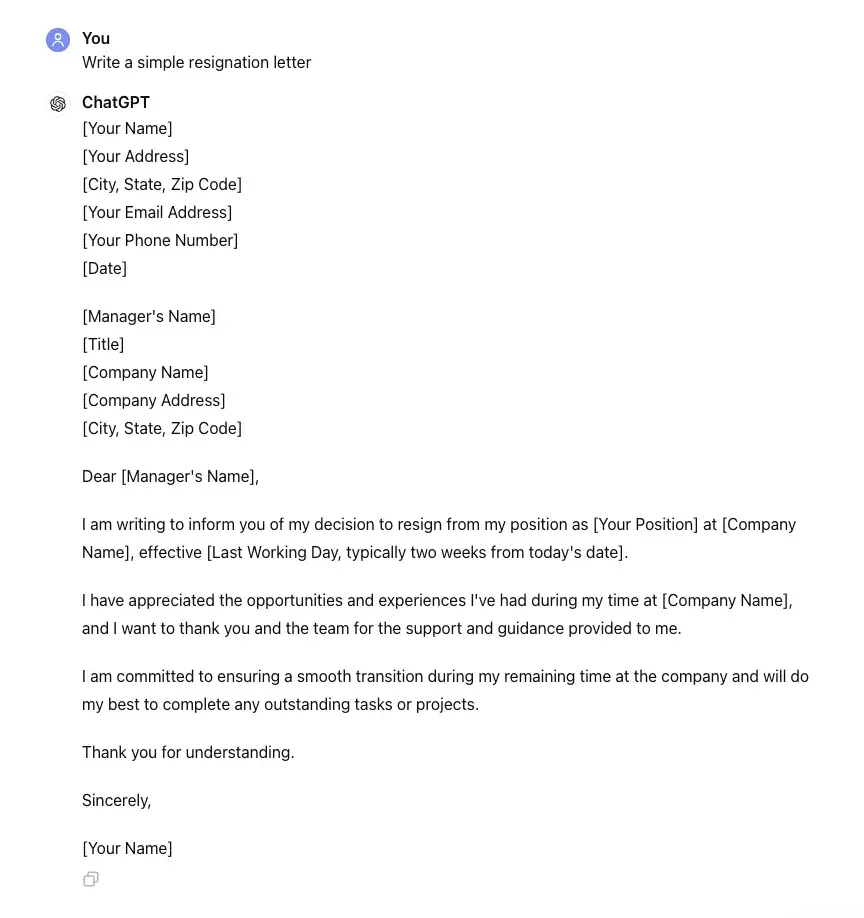
Granted, I didn’t provide any background details about my role or experience with the company, but this is a pretty good structure to help me get started:
[Date]
Dear [Manager’s Name],
I am writing to inform you of my decision to resign from my position as [Your Position] at [Company Name], effective [Last Working Day, typically two weeks from today’s date].
I have appreciated the opportunities and experiences I’ve had during my time at [Company Name], and I want to thank you and the team for the support and guidance you provided me.
I am committed to ensuring a smooth transition during my remaining time here and will do my best to complete any outstanding tasks or projects.
Thank you.
Sincerely,
[Your Name]
Another one of my favorite ways to use AI is to polish my writing, and HubSpot's AI paragraph rewriter is so great for this.
You can use it to experiment with different tones and strike the right balance. This is especially handy if you’re leaving a job with a bad taste in your mouth — been there.
Here’s an example:
Original language: I guess I learned a few things from this job, but I need to move on from this toxic environment as soon as possible.
Updated with AI paragraph rewriter: While I’ve gained some valuable insights during my time here, it’s essential for my well-being and professional growth to move on at this time.

Try HubSpot’s AI paragraph rewriter for free.
You can also use it to refresh language from a previous resignation letter or rework an output from ChatGPT to fit your current situation.
Either way, resignation letters are pretty straightforward, so I say use AI to help speed up the writing process.
OK, now let’s talk about the ideal resignation letter format.
Resignation Letter Format
I pulled one of my old resignation letters from the archive, so I’ll use this to talk about format.
(Removed all the juicy details, sry.)

January 20, 2022
Dear [Manager’s Name],
I’m writing to notify you that I’ll be leaving my role as [My Position] at [Company Name]. My last day will be February 9, 2022.
I want to thank [Company Name] for all of the support and guidance I received during my time here. It has been a pleasure working alongside people who are truly passionate about giving underrepresented communities the resources they need to lead healthier lives. The Healthcare Team here is, without a doubt, one of a kind.
During the next couple of weeks, I’ll work closely with you to make this transition as smooth as possible, and I’ll reach out to [Colleague Name] to notify [Client Name] of my departure.
Wishing the team continued success, and I look forward to staying in touch.
All the best,
Alana Chinn
alana@email.com
The format of a resignation letter should be detailed but brief. Inform your manager of your decision, but keep it professional.
I’ll break it down further in the next section for easy reference.

Writing a professional resignation letter starts with understanding each of its components. We’ll use mine as an example.

1. Date and Greeting
This part is straightforward. List the date you’re submitting your resignation letter so HR has a formal filing date. Then, greet your manager with a simple salutation.
Here’s what I did:

January 20, 2022
Dear [Manager’s Name],
2. Statement of Resignation and End Date
The fact that you’re leaving your role at the company is why you’re writing the letter in the first place, so I like to lead with that. State the position you’re resigning from and the date of your last day.
That, folks, is your statement of resignation.
Pro tip: I wouldn’t feel the need to gush here. In fact, I’d avoid openings like this:
“I'm so sorry, but I'm resigning from the role of [Your Position] in two weeks, although it's been a true pleasure working with you all. I know this is the worst, but I promise, I wouldn't if I didn't have to.”
Here’s what I did:

I’m writing to notify you that I’ll be leaving my role as [My Position] at [Company Name]. My last day will be February 9, 2022.
3. Expression of Gratitude
For the body of my resignation letter, I usually include two short paragraphs. The first expresses my gratitude for the opportunity.
Take a moment to reflect on your time at the company. Thank them for the valuable training, the supportive team environment, or even just the work experience.
If you have negative reasons for leaving, try to be as specific and genuine as possible. I'm sure you can find at least one good thing about the job … right?
Here’s what I did:

I want to thank [Company Name] for all of the support and guidance I received during my time here. It has been a pleasure working alongside people who are truly passionate about giving underrepresented communities the resources they need to lead healthier lives. The Healthcare Team here is, without a doubt, one of a kind.
4. Transition Details
Onto the second body paragraph: the one that briefly talks about my transition plan. Here, I note how I’ll help tie up any loose ends and make the transition as seamless as possible.
Pro tip: I recommend creating a separate transition plan that outlines your projects and tasks with full details on how you’ll hand over your responsibilities.
No need to include that in your resignation letter.
Here’s what I did:

During the next couple of weeks, I’ll work closely with you to make this transition as smooth as possible, and I’ll reach out to [Colleague Name] to notify [Client Name] of my departure.
5. Closing Paragraph and Contact Information
To wrap things up, I usually include a closing paragraph with well wishes and an opening to stay in touch. I’ll add a link to my LinkedIn profile (if we’re not already connected) and my personal email address.
You can add your phone number too, if you feel moved to do so.
Here’s what I did:

Wishing the team continued success, and I look forward to staying in touch.
All the best,
Alana Chinn
alana@email.com
1. Future Career Moves
While you can mention where you're going next, I don’t recommend telling your employer about your new position at length. Keep things professional and focus on setting your existing team up for success before your departure.
2. Distasteful Language
While you may feel the urge to criticize your former job, the resignation letter isn't the time to air out the dirty laundry.
Trust me, you never know when you might cross paths with your old colleagues in the future — especially if you’re staying in the same industry.
George Cotter, SEO consultant at Tall Marketing says, “If you are leaving because of a conflict or something overtly negative, remember, you‘re resigning — it says all they need to know. You don’t need to tell them again.”
You’re on your way out anyway. Let that speak for itself.
3. Emotional Attachments
It’s not uncommon to form connections with your teammates. I’ve been known to have a work bestie or two. However, save the emotional sentiments for face-to-face conversations.
Your resignation letter is a professional document, so I say stick to the formalities.
4. Criticism of Coworkers
Similar to distasteful language, your resignation letter doesn't need to include negative comments about your colleagues or managers at the company. The letter is meant to conclude your tenure — stay focused.
5. Anger or Bitterness
The reality is you may be leaving a job with some resentment. I know I have.
But expressing anger or bitterness on your way out is not the way to go.
Daniel Cook, HR/marketing executive at Mullen and Mullen says, “I like to avoid negativity, as this is not the place to air grievances or provide criticism about the company or co-workers.
Even if I am leaving because of negative experiences, a resignation letter should be focused on moving forward — not on past complaints.”
Try to reflect on positive moments and how you gained useful knowledge about the industry rather than airing out the dirty laundry.
For more tips, watch what HubSpotter Jamal Meneide has to say on the topic of resignation letters:
Free Professional Resignation Letter Templates
Let’s face it: We have just about everything at HubSpot, including free resignation letter templates (hooray, we all say in unison). These templates are versatile and super easy to customize based on your role.
Download the Templates for Free
I pulled out a few of my favorite one-size-fits-all options from the pack.
General Resignation Letter Template
[Header]
[Date]
Dear [Manager's Name],
I’m writing first and foremost to thank you for my experiences at [Company Name] for the last [Time Spent Working at Company]. During this time, I’ve [Outline Positive Experiences/Learnings/Relationships During Your Tenure].
Today, I’m sharing the news of my difficult decision to resign from my role as [Your Position] at [Company Name]. My last day will be [Last Working Date].
The decision to move on was not easy, but I believe it the best thing for me at this time. I have been afforded the opportunity to [Describe New Role/Opportunity], which will allow me to [Explain Benefits of Transition].
I look forward to making the next [Length of Time Until Departure] as positive and productive as possible. I want to leave this team in the best shape for the organization and my replacement, and will be happy to work in whatever capacity is needed until my last day. Please let me know what I can do to help during this transitional period.
Once again, please accept my sincerest thanks for everything these past [Time Spent Working at Company]. I wish nothing but success for this company and team in the future and hope to stay connected. You may reach out to me at any time at [Email or Phone Number].
Sincerely,
[Your Name]
What I like: This resignation letter template is a good one because it provides space for you to thank your manager, outline positive experiences from your time at the company, share your last day, and talk about why you decided to leave.
New Opportunity Resignation Letter Template
[Header]
[Date]
Dear [Manager's Name],
Please accept this message as my letter of resignation from my role as [Your Position] at [Company Name], effective [Last Working Date].
After this time, I will be [Describe New Opportunity].
During this time of transition, I will aim to be as supportive as possible to this team. Specifically, I plan to [Outline Steps You’ll Take to Ensure a Smooth Transition]. If I am needed in any other capacity before my departure, please let me know and I will be glad to assist however I can.
While I will be moving on, I know I will look back on my time at [Company Name] with fondness and gratitude. Specifically, [Positive Memory or Contribution #1] and [Positive Memory or Contribution #2] will always be moments for which I will always be appreciative.
Thank you for your support and understanding during this time. I look forward to ensuring a successful transition for my team and my replacement.
All the Best,
[Your Name]
What I like: If you're interested in sharing details about the next steps in your career, this is a great template to use. It also gives you the opportunity to reflect on your experience and accomplishments at the company with gratitude.
Reason for Leaving Resignation Letter Template
[Header]
[Date]
Dear [Manager's Name],
I would like to formally notify you of my decision to part ways with [Company Name], effective [Last Working Date].
The reason for my resignation is [Reason(s) for Resignation]. While I would have liked to continue working for [Company Name], I have decided the best option for me was to move on, because [Reason(s) for Departure].
I understand that my departure may cause some disruption, and so I’d like to be as helpful as possible before I go. Please do not hesitate to let me know how I can assist in an effective transition.
Thank you for this experience. I wish this company and everyone who works here all the best.
Sincerely,
[Your Name]
What I like: This resignation letter template gives you the space to explain your reason for departure, should you choose to do so. However, it‘s still a simple and concise way to let your current company know you’re planning to move on.
Job Resignation Letter Templates
While HubSpot's templates are great for all-purpose use, I recognize that certain positions — like healthcare and C-suite roles — merit a more specific letter of resignation when you leave.
I've included a few templates for some of these more dynamic roles below.
1. Contractor Resignation Letter Template
As a contractor, you may need to adjust the focus of your resignation letter to address your final assignments, unfinished tasks, and how you’ll accept your final payment.
Use this template:

[Header]
[Date]
Dear [Manager’s Name],
I regret to inform you that I will be resigning from my position as the [Department] Freelancer as my contract with [Company Name] expires on April 20, 2022.
I have enjoyed my time here, and I have learned and grown a great deal. I am happy to have been a part of the company, and I would like to thank you for the opportunities I have had.
I am saddened to be moving on from the company, but I am going to be taking on new challenges with [New Company Name]. I hope my experience here has helped the company with its projects, and I am happy to have been a part of the team.
If you have any questions or concerns, please feel free to contact me. I will be available to help you with any final projects.
Sincerely,
[Your Name]
2. Executive Resignation Letter Template
A quick email or two-paragraph notice to your superior might not suffice as an official resignation if you're in an executive- or senior-level leadership role.
Because these roles are harder to fill, you might play a more significant role in the transition period.
Use this template:

[Date]
Dear [Leadership Entity],
Please let this letter serve as my resignation as [Your Position] at [Company] effective [Last Working Date].
I will cherish the friends I have made and hold onto the many accomplishments that are part of my history with [Company Name]. As we part ways, I’m proud we were able to [List of Major Accomplishments].
I am confident that the board will be able to find an excellent replacement for [Your Position] and continue the company’s well-deserved success.
For all future communications, you can reach me by phone at [Phone Number] or by email at [Email Address].
I wish you and the company the best in the future.
Sincerely,
[Your Name]
3. Teacher Resignation Letter Template
As a teacher, you may want to hold space to discuss your experience working with students and how you will help your temporary or full-time replacement with the transition.
Use this template:

[Date]
Dear [Leadership Entity],
Please accept this letter as my formal resignation from my position as [Your Position] at [School Name]. To ensure ample time for a smooth transition, my last day of employment will be [Last Working Day].
My experience as an educator has been insightful, challenging, and fulfilling, and working with the [School Name] students has brought me great joy. Thank you for the opportunity to invest in the lives of children through learning and play. I am grateful to have been part of this team and will carry the many lessons I learned with me into my future endeavors.
Because the continued success and care of the students are of the utmost importance to me, I am dedicated to doing whatever I can to make the transition as seamless as possible. I am happy to train my replacement on our current curriculum and [List of Responsibilities].
I wish all the best for the [School Name] students, teachers, and administration. Thank you again for your support and leadership during my time here.
Sincerely,
[Your Name]
4. Nurse Resignation Letter Template
As a nurse, it's important to give adequate notice of your departure to ensure there are no healthcare disruptions for your patients.
You can use your resignation letter to thank your employer for the experience and offer training support for your successor.
Use this template:
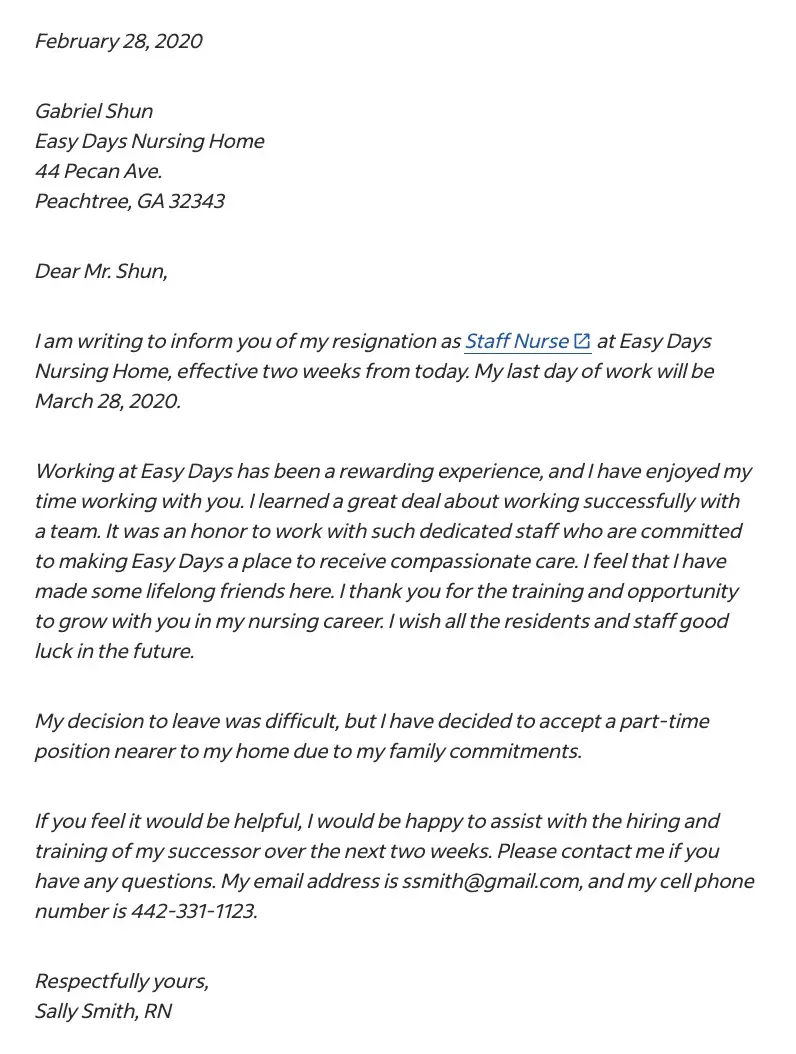
[Date]
Dear [Manager’s Name],
I am writing to inform you of my resignation as [Your Position] at [Facility Name], effective two weeks from today. My last day of work will be [Last Working Day].
Working at [Facility Name] has been a rewarding experience. I have enjoyed my time with you and learned a great deal about working successfully with a team.
It was an honor to work with such dedicated staff who are committed to making [Facility Name] a place to receive compassionate care. I thank you for the training and the opportunity to grow with you in my career. I wish all the residents and staff good luck in the future.
If you feel it would be helpful, I would be happy to assist with the hiring and training of my successor over the next two weeks.
Please feel free to contact me if you have any questions. My email address is [Email Address], and my cell phone number is [Phone Number].
Sincerely,
[Your Name]
Resignation Letter Examples
Now that you have a few templates under your belt, I’m going to share some hypothetical (!) examples of resignation letters from my current position as Marketing Blog editor at HubSpot.
That way, you can see some of the blanks filled in with real information.
Short Resignation Letter Examples
Short resignation letters are great for situations where:
- You need to leave a job abruptly for personal (or professional) reasons.
- You don’t want to overshare details about your departure or next steps.
- You’re unhappy with your experience and want to remain professional.
- You haven’t been with the company for very long.
Here are two short resignation letter examples using my role as an inspo:
Example 1:

November 15, 2024
Dear Meg,
I’m writing to inform you that I will be resigning from my position as Marketing Blog Editor at HubSpot on November 30, 2024.
I appreciate the opportunity to grow as a content strategist during my time here. I am committed to working with you and the rest of the Blog team to facilitate a smooth transition before my departure.
Thanks again for the opportunity to be a part of such a fantastic team and HubSpot’s impactful work.
Sincerely,
Alana Chinn
Example 2:

November 15, 2024
Dear Meg,
I’m writing to notify you that I’ll be leaving my role as Marketing Blog Editor at HubSpot. My last day will be November 30, 2024.
I want to thank you, the Blog team, and HubSpot for all of the support and guidance I received during my time here. My goal is to make this transition as smooth as possible over the next couple of weeks.
Wishing the team continued success, and many more well-timed GIFs.
Sincerely,
Alana Chinn
Long Resignation Letter Example
Longer resignation letters work well if:
- You’re leaving on a positive note and want to emphasize that.
- You’ve been with the company for a while and have built close relationships.
- You want to leave things open to work together again in the future.
Here’s an example (again, using my role as an inspo):

November 15, 2024
Dear Meg,
I am writing to formally announce my resignation from my position as Marketing Blog Editor at HubSpot, effective November 30, 2024. This decision has been made after careful consideration and reflection of my professional goals.
I want to express my gratitude to you and the entire Blog team for your support and camaraderie during my time here. Thanks to HubSpot, I’ve had opportunities for growth and learning as a content strategist that I will be able to take with me.
I am committed to ensuring a smooth transition during my last two weeks with the company. I’m willing to assist with the handover of my responsibilities and support any training for the acting editor.
Thank you again for the opportunity to be a part of the HubSpot Blog team. I wish you all nothing but continued success in the future, and I look forward to keeping in touch.
Sincerely,
Alana Chinn
Professional Resignation Letter Samples
Haven’t had enough yet?
I’m a firm believer that you can never have too many examples. So, here are some more resignation letter samples for even more scenarios.
1. Gracious Resignation Letter Sample
For times when you can honestly say you loved your job:

[Date]
Dear Manager,
I would like to inform you that I am resigning from my position as Data Analyst for Company A, effective November 30, 2024.
I appreciate the opportunities for professional development that you have provided me over the past four years. I have enjoyed my tenure at Company A, and feel grateful to have started my career alongside such a dedicated team.
I have accepted a teaching position in Virginia. While my experience at Company A was rewarding, I'm excited to pursue my passion for teaching.
If I can be of any help during this transition, please let me know. I am willing to help out with freelance work until you find a replacement.
Thank you again for the opportunity to work at Company A. I wish you all the best and look forward to staying in touch. You can email me at alana@email.com.
Sincerely,
Alana Chinn
2. Immediate Resignation Letter Sample
For times when you have to leave your job sooner than anticipated:

[Date]
Dear Manager,
I regret to inform you that I'm resigning from my position as the Data Analyst at Company A, effective immediately.
While my contract requires me to work until December 31, 2024, I would be grateful if I could cease working immediately. I sincerely apologize for any inconvenience this sudden news may cause.
Thank you for the fantastic opportunities you've offered me to grow professionally and personally.
Please let me know if there is anything I can do to make the transition smoother.
Sincerely,
Alana Chinn
3. Retirement Resignation Letter Sample
For the time when you’re officially, really, and truly off the clock:
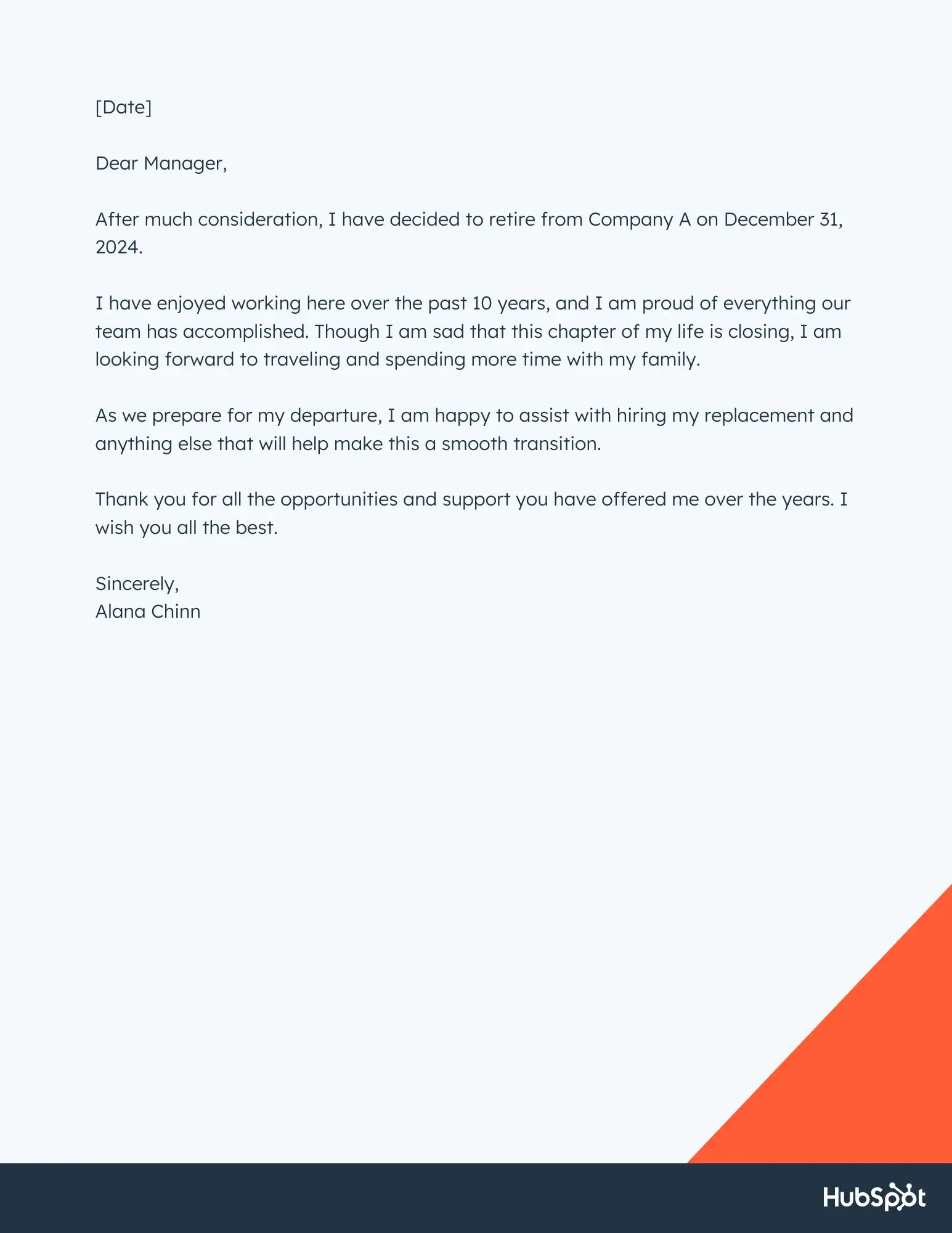
[Date]
Dear Manager,
After much consideration, I have decided to retire from Company A on December 31, 2024.
I have enjoyed working here over the past 10 years, and I am proud of everything our team has accomplished. Though I am sad that this chapter of my life is closing, I am looking forward to traveling and spending more time with my family.
As we prepare for my departure, I am happy to assist with hiring my replacement and anything else that will help make this a smooth transition.
Thank you for all the opportunities and support you have offered me over the years. I wish you all the best.
Sincerely,
Alana Chinn
4. Extended Notice Resignation Letter Sample
For times when you’re able to provide ample time for transition:
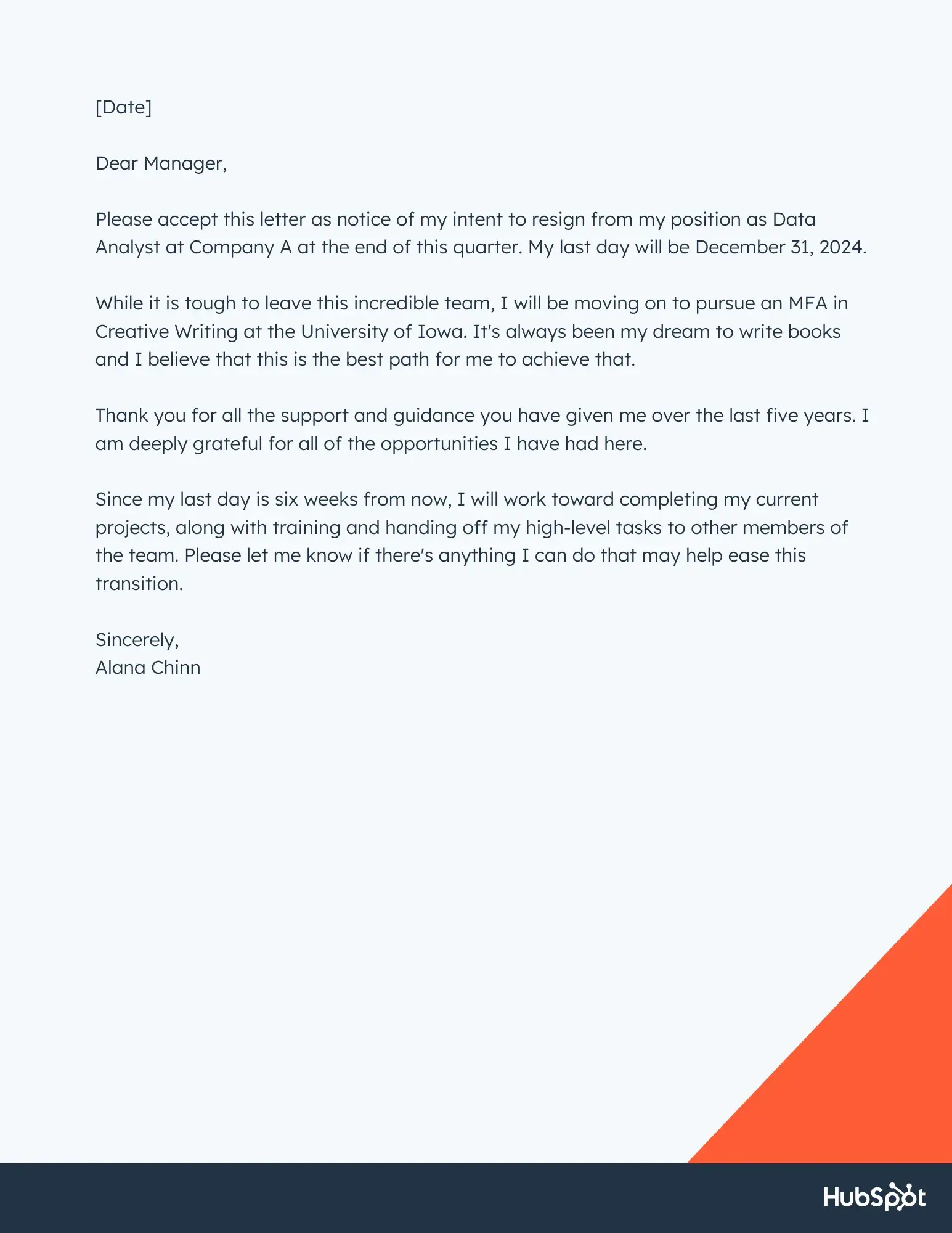
[Date]
Dear Manager,
Please accept this letter as notice of my intent to resign from my position as Data Analyst at Company A at the end of this quarter. My last day will be December 31, 2024.
While it is tough to leave this incredible team, I will be moving on to pursue an MFA in Creative Writing at the University of Iowa. It's always been my dream to write books and I believe that this is the best path for me to achieve that.
Thank you for all the support and guidance you have given me over the last five years. I am deeply grateful for all of the opportunities I have had here.
Since my last day is six weeks from now, I will work toward completing my current projects, along with training and handing off my high-level tasks to other members of the team. Please let me know if there's anything I can do that may help ease this transition.
Sincerely,
Alana Chinn
5. Personal Reasons Resignation Letter Sample
For times when life throws you a curveball:
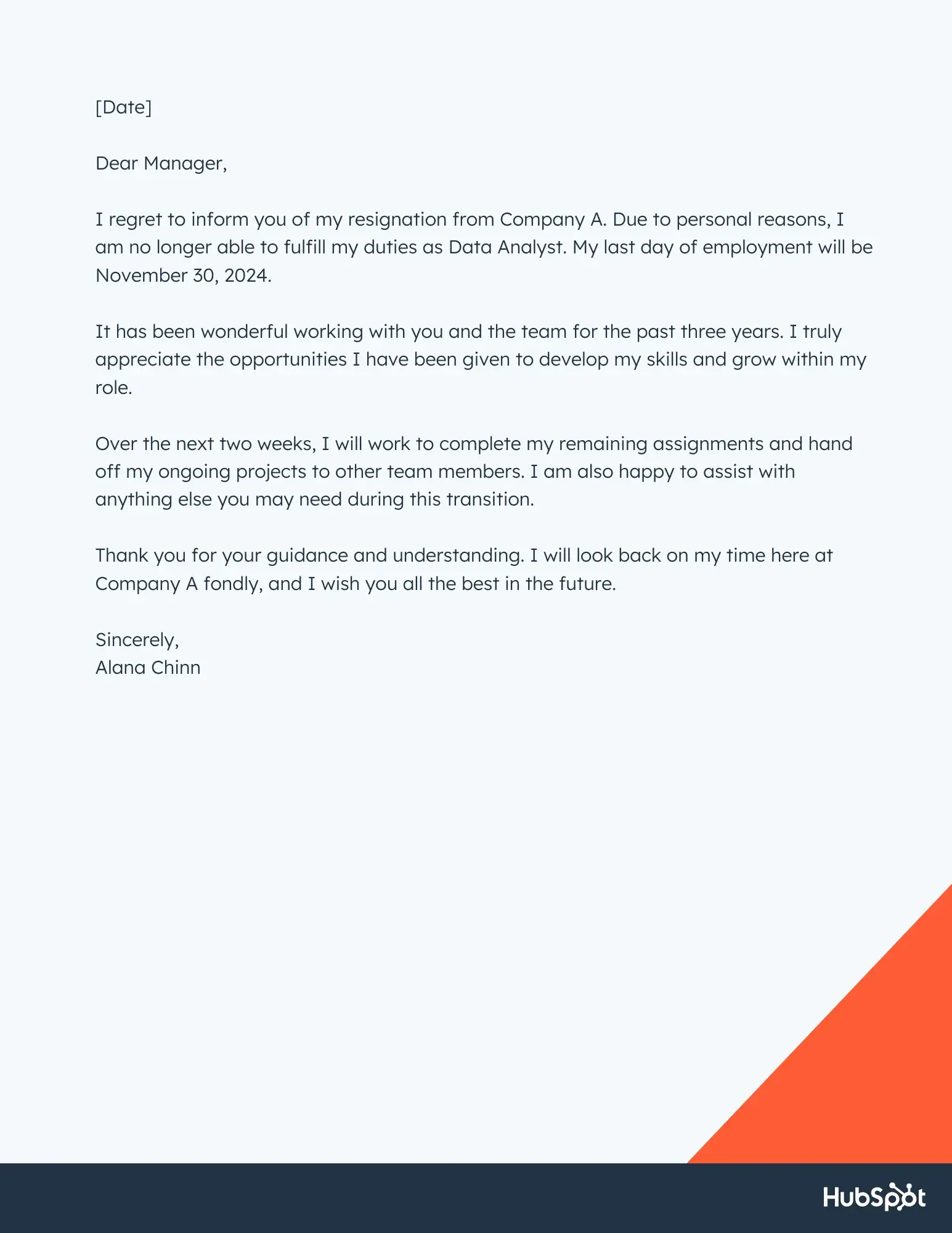
[Date]
Dear Manager,
I regret to inform you of my resignation from Company A. Due to personal reasons, I am no longer able to fulfill my duties as Data Analyst. My last day of employment will be November 30, 2024.
It has been wonderful working with you and the team for the past three years. I truly appreciate the opportunities I have been given to develop my skills and grow within my role.
Over the next two weeks, I will work to complete my remaining assignments and hand off my ongoing projects to other team members. I am also happy to assist with anything else you may need during this transition.
Thank you for your guidance and understanding. I will look back on my time here at Company A fondly, and I wish you all the best in the future.
Sincerely,
Alana Chinn
Ready, Set, Resign
“Remember, your resignation letter is part of your professional brand, says Harmanjit Singh, founder & CEO of Website Design Brampton. “It's like your digital footprint — it lasts longer than you might think.”
My final advice? Don’t let one bad experience keep you from building your professional bridges and keeping your network intact as you start your next adventure.
Best of luck with your graceful goodbye!
Editor's note: This post was originally published in October 2018 and has been updated for comprehensiveness.



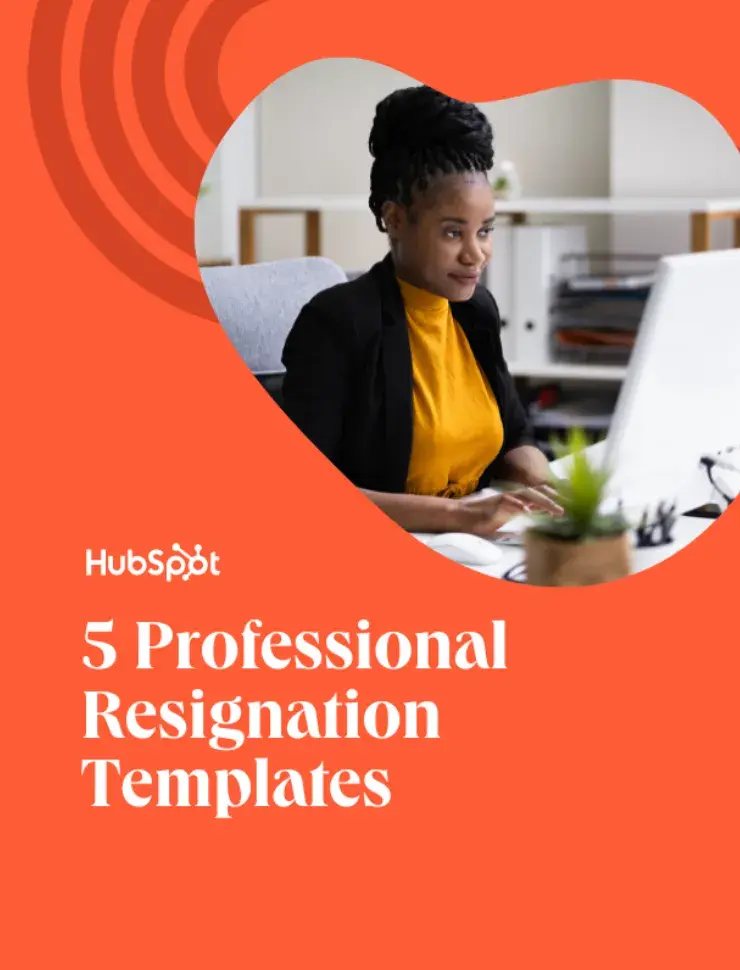














![Download Now: The 2024 State of Social Media Trends [Free Report]](https://no-cache.hubspot.com/cta/default/53/3dc1dfd9-2cb4-4498-8c57-19dbb5671820.png)



![Can Facebook attract Gen Z, quote graphic, I think there is an opportunity for [Facebook] to rebrand themselves. However, they have 20 years of reputation to work against, Reece Callaway, Brand and Social Content Manager at HubSpot](https://www.hubspot.com/hs-fs/hubfs/Quote%20Graphic%204%20-%20RC.webp?width=598&height=398&name=Quote%20Graphic%204%20-%20RC.webp)
![→ Download Now: The Illustrated Guide to Org Charts [Free Guide + Templates]](https://no-cache.hubspot.com/cta/default/53/7cbd0328-6c8c-40e0-98dd-c3b6e6be96f0.png)






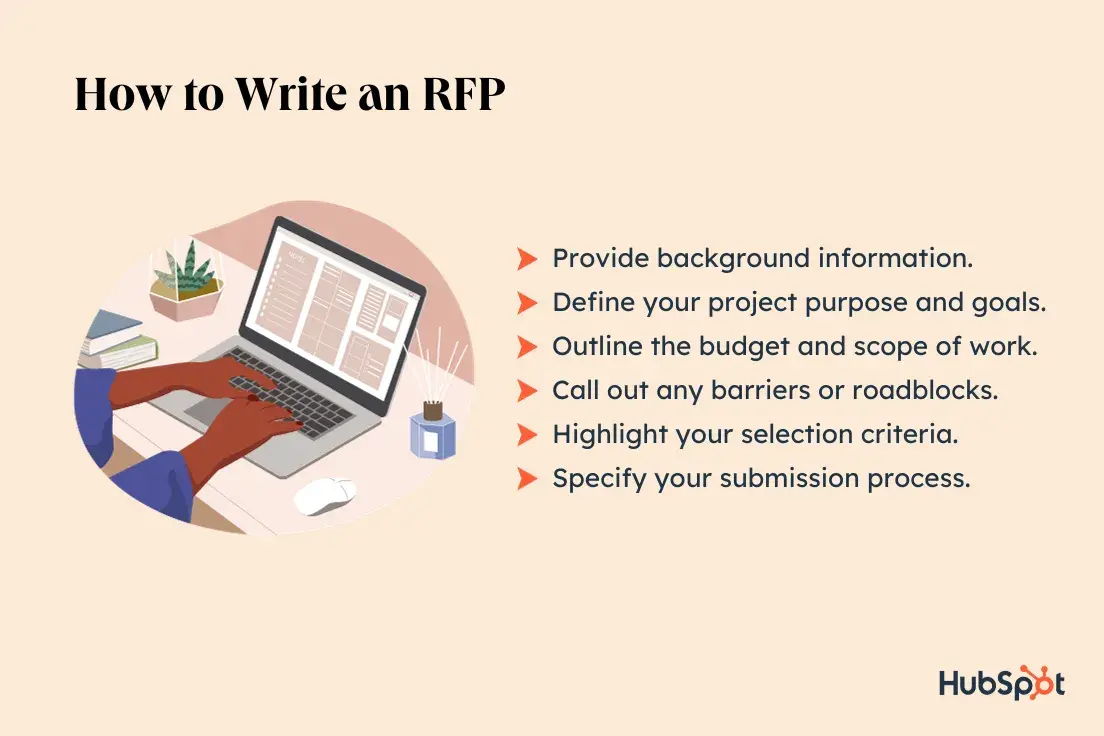

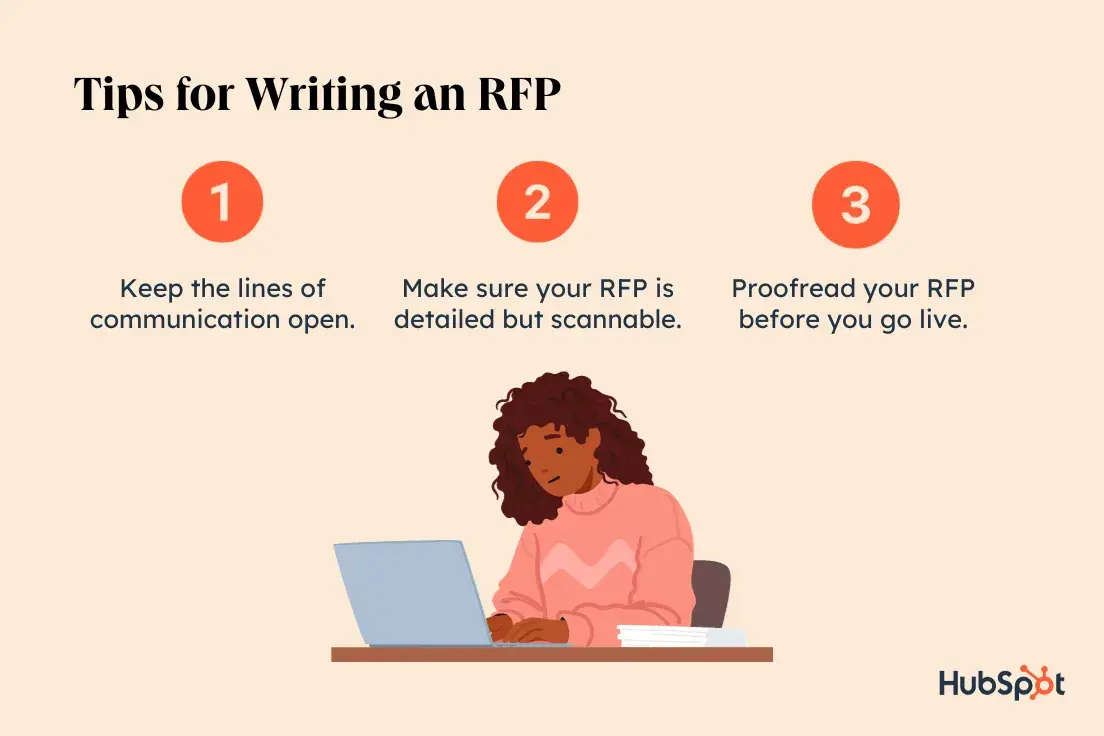
![Download Now: Free State of Marketing Report [Updated for 2024]](https://no-cache.hubspot.com/cta/default/53/db725f24-564c-483b-a28c-2d6ff9986516.png)


